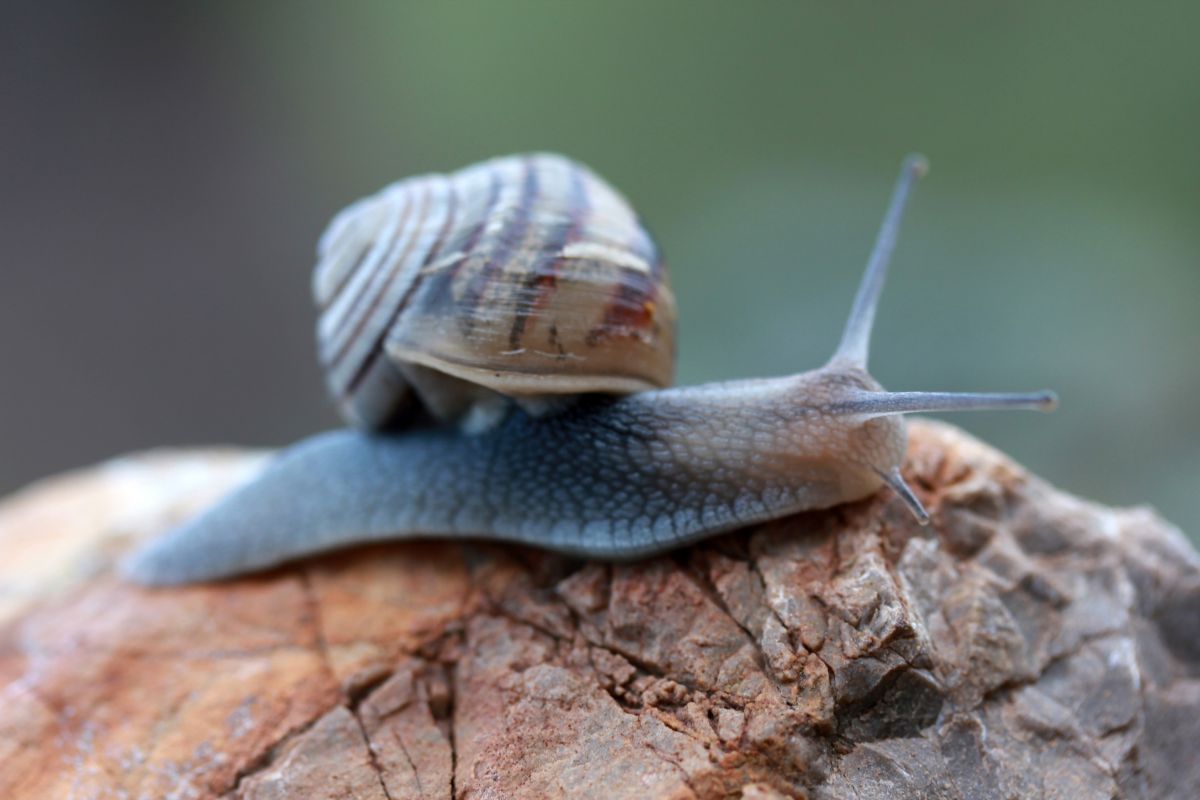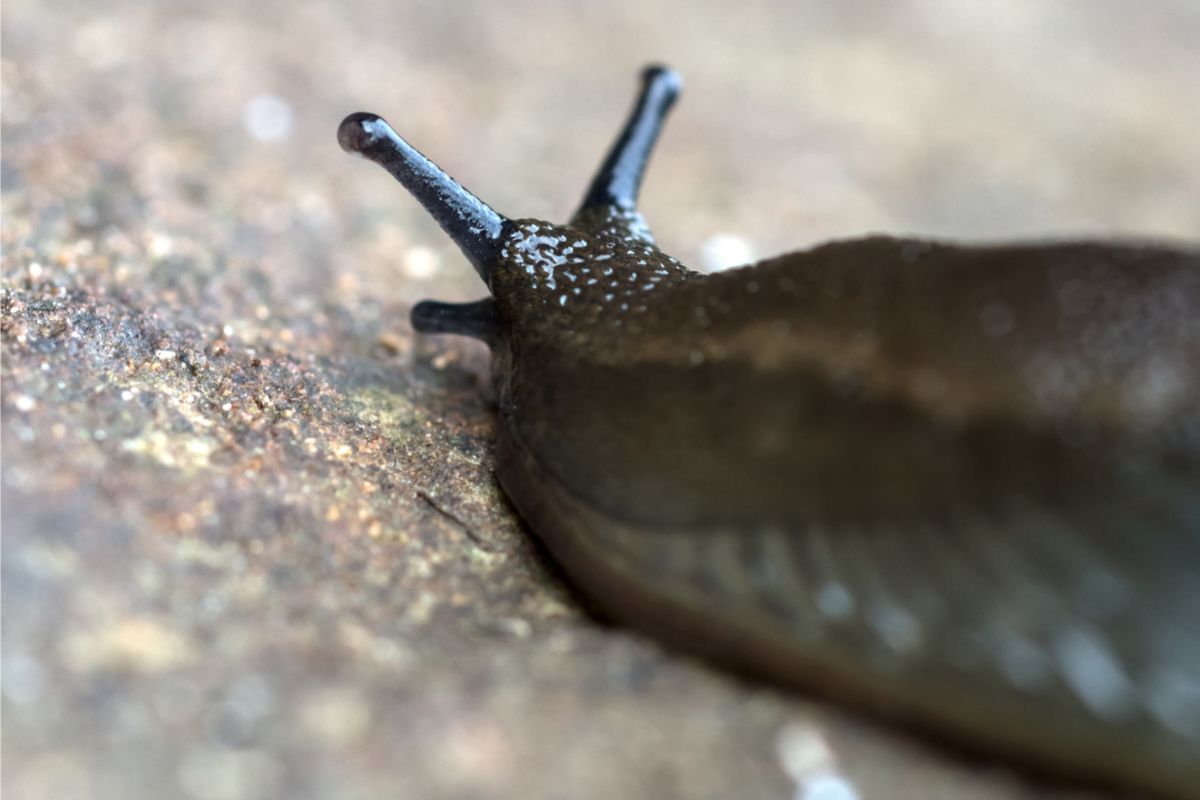What are Slugs?
What are slugs, and where do slugs live? Slugs are normal garden pests. Scientifically, they belong to the mollusk group, and you can classify them as gastropods. They usually glide on one muscular foot leaving a mucus trail behind as they move.
What does a slug look like? Slugs differ from snails because they don’t have the tough, protective shell. Additionally, they have two tentacles on their front with eyes on the tips for smelling and seeing.
They also have two lower tentacles which they use for tasting and touching. Slugs usually slide over plants when feeding.

Where do Slugs Live?
The ideal environment for slugs is warm and humid. They love places like the east and west coasts of the United States. Moreover, their main need is moisture; therefore, they’ll survive as long as the environment is warm and moist.
In this sense, lawns and gardens in warm environments attract slugs because they have a lot of moisture. They also provide the slugs shade from the wind and sun.
Besides, the gardens are full of young leaves and shoots, perfect food for slugs. During the hot summer months, slugs need shelter to avoid drying out because of the sun. Consequently, they look for damp places to stay during the day and come out to feed at night.
Slugs usually hide under leaf debris and other objects on the ground. Therefore, you can minimize the slug population on your property by reducing these things.
What do Slugs Eat?
Slugs usually feed on living and decomposing plant material. They eat the young plants first, particularly those in your vegetable gardens like basil, lettuce, and other foliage plants.
How will you know slugs have invaded your garden? Slugs feed by sliding on the plant’s leaves and leaving behind big holes. They also feed on fruits such as tomatoes and strawberries.
Additionally, they sometimes go under the soil seeking moisture and feeding on seeds and newly planted plant roots. Slugs have rows of tiny teeth in their mouths which they use for shredding leaf tissue.
It is difficult to catch slugs in action because they feed at night. The best way to discover them is by looking at the damage they leave behind and mucus trails.
Slugs can destroy a plant because they consume more than their weight. Furthermore, they can travel up to 40 feet (12.19 meters) while feeding.
Slugs vs. Snails
Many people usually confuse slugs with snails. While the two have many similarities, a few features make them different. Here is a breakdown:
Appearance
Slugs have a soft body. Adult slugs measure between 0.08 to 0.33 feet (25 to 100 millimeters) long, depending on the species. Because they don’t have a shell, they sp(end most of their time underground.
On the other hand, snails also have soft bodies and shells. The snails can withdraw inside the shells to hide from harsh conditions and stay alive for several years.

Where They Hide
Slugs and snails hide in moist places during the day. They usually stay underneath logs and stones or below ground cover. Moreover, they can hide under low decks and planters.
During the night, they come out to feed. You’ll know they were in your garden if you see a slimy trail they make as they move.
Diet
Slugs and snails eat plant leaves. Snails need calcium in their diet because they have shells. Therefore, if limestone is scarce, they sometimes feed on painted surfaces.
Reproduction
Slugs and snails reproduce by laying eggs. They usually lay the eggs in the spring and summer and put them in moist, secluded areas. The slug eggs in the soil hatch to baby slugs and develop into maturity in a few months.
Snails cover their eggs with soil, hatching in a few days. They develop into adults in a few months. Slugs and snails can live for quite a few years.
Where do Slugs Come From?
As mentioned earlier, slugs thrive in moist environments. Therefore, they’ll come alive whenever it rains or you’ve watered your lawns.
They usually live in the soil, and the water makes them move to the top in search of moisture. Moreover, slugs prefer coming out at night because it is more serene and moist, and the predators are few.
What Eats Slugs?
The knowledge of what eats slugs is critical information. If you can attract slug predators to your garden, it will be easier to control the slug population.
The most common slug predators include chickens, snakes, ducks, and toads. In this sense, your best bet would be to attract toads and non-poisonous snakes to your garden. These two predators will eat the slugs without damaging your plants.
Is a Slug an Insect?
A slug is not an insect. Insects belong to the Phylum Arthropoda, while slugs belong to the Phylum Mollusca. As a result, scientists relate them to squids more than other bugs.
How to Get Rid of Slugs in the Garden
Like many other pests in your garden, the secret to getting rid of slugs is having an effective preventive strategy. Here are some practical tips on how to get rid of slugs.
Reduce Moisture Levels
Slugs love a moist environment which explains why many end up in your flower beds. It is essential to keep your plants watered. However, over-watering them creates a perfect environment for slugs to thrive.
Therefore, it would help to water your plants as much as they need. This approach will help you keep slugs away from your crops.
Alternatively, water your plants in the morning to ensure they are dry during the night. Also, consider drip irrigation to keep the plants dry and discourage slugs.
Use Anti-Slug Pellets, Sprays, and Powders
Slug pellets, sprays, and powders effectively kill these pests and keep them off your garden. But, most of these products use metaldehyde, which is poisonous to cats, dogs, and other wildlife.
Therefore, go for pellets containing iron phosphate to avoid decimating other creatures in the surrounding area. Iron Phosphate contains naturally occurring ingredients that do not harm non-target species.
Put a Slug Barrier
A slug barrier can be an effective way to keep slugs off your vegetables. Additionally, it is not toxic, so you wouldn’t worry about harming other species.
Make an ideal barrier using copper strips around plants to keep slugs away. They’ll get a mild electric shock if they attempt to cross the copper wire. So, they will stay on their side of the barrier, away from your plants.
What are Slugs Good For?
Slugs play a critical role in keeping the balance of the environment. For example, they are food for birds and other creatures pollinating flowers.
Besides that, you can also put them in a compost bin to help make organic compost. You can use this organic matter to fertilize plants. They will not glide away from the compost pit because they have everything they need there.
Slugs also play an essential role in cleaning up rotting vegetation and garden debris. This clean-up helps to keep your plants healthy. They also eat other things that can damage your gardens, like animal carcasses and dog excrement.
What Causes Slug Infestation?
Most people usually ask – how did I get slugs in my garden? If your garden has moist plant debris, low-growing weeds, underneath rocks, mulch, and fallen logs providing hiding places for slugs.
Moisture is a critical requirement for slugs since dry conditions affect them badly. Moreover, the moist places are favorable for slugs if they can find a food source nearby.
Preventing Slug Eggs in Soil
Slugs are hermaphrodites (have male and female reproductive organs). They usually lay eggs through self-fertilization. Slugs usually lay slimy white, transparent, round eggs. You’ll find slug eggs in soil cracks, leaf litter, and below plant debris.
To know where you’ll locate the eggs, find out where do slugs live during the day. This knowledge makes it effortless to find the slug eggs.
Since one slug can lay up to 40 eggs in one batch, getting rid of them might not be very straightforward. The best way to get rid of these eggs is to pour salty water on them and use tweezers to destroy them.
Alternatively, you can handpick the eggs and place them in slightly salty or soapy water to poison them. However, slugs’ natural enemies also eat their eggs.
Finally, you can use a bleach mixture to eliminate slug eggs in the soil. Mix bleach with water, remove eggs from the soil, and submerge them into the mixture to destroy them.

We’re Out!
Slugs are interesting animals that can wreak havoc on your garden. They are also hard to find because they are nocturnal. During the day, they hide beneath materials in the garden.
If you don’t control the spread of slugs in your garden, they can cause much damage because they consume more than their weight. Fortunately, you can get rid of what attracts slugs from your garden, and you’ll keep them away!
